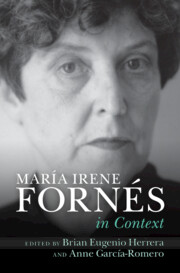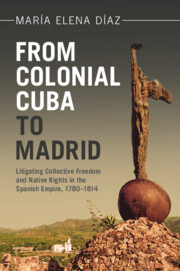Refine search
Actions for selected content:
164 results

María Irene Fornés In Context
-
- Published online:
- 27 August 2025
- Print publication:
- 07 August 2025
Chapter 23 - Elder
- from Part III - Culture, Society, and Politics
-
-
- Book:
- María Irene Fornés In Context
- Published online:
- 27 August 2025
- Print publication:
- 07 August 2025, pp 254-270
-
- Chapter
- Export citation
Chapter 9 - Susan Sontag
- from Part I - Places and People
-
-
- Book:
- María Irene Fornés In Context
- Published online:
- 27 August 2025
- Print publication:
- 07 August 2025, pp 90-100
-
- Chapter
- Export citation
Chapter 1 - “Lost in Translation”
-
-
- Book:
- Antifascism(s) in Latin America and the Caribbean
- Published online:
- 21 July 2025
- Print publication:
- 07 August 2025, pp 23-40
-
- Chapter
- Export citation
Chapter 16 - Translation and Adaptation
- from Part II - Theatre
-
-
- Book:
- María Irene Fornés In Context
- Published online:
- 27 August 2025
- Print publication:
- 07 August 2025, pp 171-180
-
- Chapter
- Export citation
Chapter 11 - Anarchist Media, Cuba’s War for Independence, and the Forging of a Radical Transnational Latinidad, 1880s–1890s
- from Part III - Transgressing
-
-
- Book:
- Latinx Literature in Transition, 1444–1886
- Published online:
- 06 August 2025
- Print publication:
- 17 July 2025, pp 252-270
-
- Chapter
- Export citation
Chapter 16 - Mars Is Oggún
- from Part IV - Transcreating
-
-
- Book:
- Latinx Literature in Transition, 1444–1886
- Published online:
- 06 August 2025
- Print publication:
- 17 July 2025, pp 363-386
-
- Chapter
- Export citation
Chapter 8 - “Tragic Time”
- from Part II - Transcending
-
-
- Book:
- Latinx Literature in Transition, 1444–1886
- Published online:
- 06 August 2025
- Print publication:
- 17 July 2025, pp 190-206
-
- Chapter
- Export citation
Stavert, Zigomala & Co.: A Transnational History of the Anglo-Cuban Textile Trade During 1860s–1914
-
- Journal:
- Enterprise & Society , First View
- Published online by Cambridge University Press:
- 14 July 2025, pp. 1-46
-
- Article
-
- You have access
- Open access
- HTML
- Export citation
Chapter 13 - Cyberspace (S)exiles
- from Part III - Emerging Media
-
-
- Book:
- Latinx Literature in Transition, 1992–2020
- Published online:
- 19 June 2025
- Print publication:
- 03 July 2025, pp 240-257
-
- Chapter
- Export citation
15 - Social Medicine, Otherwise
-
-
- Book:
- Medicine on a Larger Scale
- Published online:
- 05 May 2025
- Print publication:
- 22 May 2025, pp 297-317
-
- Chapter
-
- You have access
- Open access
- HTML
- Export citation
Habsburg in Havana. Outsider Participation in the Spanish Empire: the Slaving Licence of Romberg & Consors of Ghent, 1780–90
-
- Journal:
- Itinerario / Volume 49 / Issue 1 / April 2025
- Published online by Cambridge University Press:
- 19 February 2025, pp. 79-98
-
- Article
-
- You have access
- Open access
- HTML
- Export citation
2 - The Americas and Atlantic Slave Trading: The Iberians and the Rest
-
- Book:
- Atlantic Cataclysm
- Published online:
- 13 December 2024
- Print publication:
- 13 February 2025, pp 46-100
-
- Chapter
- Export citation
3 - The Economic Effect of Secondary Sanctions on Firms
- from Part I - Secondary Sanctions
-
-
- Book:
- The Cambridge Handbook of Secondary Sanctions and International Law
- Published online:
- 14 December 2024
- Print publication:
- 12 December 2024, pp 37-63
-
- Chapter
- Export citation
5 - The EU and the Politics of US Secondary Sanctions
- from Part I - Secondary Sanctions
-
-
- Book:
- The Cambridge Handbook of Secondary Sanctions and International Law
- Published online:
- 14 December 2024
- Print publication:
- 12 December 2024, pp 93-114
-
- Chapter
- Export citation
5 - The Council’s Ruling and the Politics of Litigation
-
- Book:
- From Colonial Cuba to Madrid
- Published online:
- 14 November 2024
- Print publication:
- 21 November 2024, pp 178-207
-
- Chapter
- Export citation
7 - Violence, Marronage, and Litigation
-
- Book:
- From Colonial Cuba to Madrid
- Published online:
- 14 November 2024
- Print publication:
- 21 November 2024, pp 230-256
-
- Chapter
- Export citation

From Colonial Cuba to Madrid
- Litigating Collective Freedom and Native Rights in the Spanish Empire, 1780–1814
-
- Published online:
- 14 November 2024
- Print publication:
- 21 November 2024
‘La Nación y la Emigración’: How Post-Soviet Era Cuba Designed its Diaspora Statecraft
-
- Journal:
- Journal of Latin American Studies / Volume 56 / Issue 3 / August 2024
- Published online by Cambridge University Press:
- 17 January 2025, pp. 523-547
- Print publication:
- August 2024
-
- Article
-
- You have access
- Open access
- HTML
- Export citation
14 - Sex Tourism: Fluid Borders of Meanings and Practices
-
-
- Book:
- The Cambridge World History of Sexualities
- Published online:
- 26 April 2024
- Print publication:
- 16 May 2024, pp 297-317
-
- Chapter
- Export citation
